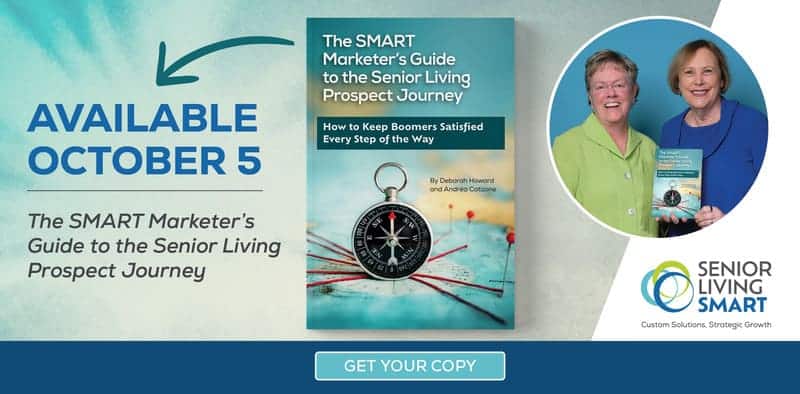Senior Living Leads Stuck in Pre & Post-Tour Stages: What to Do

Tackling occupancy issues in your community often means finding untapped opportunities within your existing senior living leads, such as those stuck in the pre-tour and post-tour stages.
By effectively re-engaging these segments, you’ll move more pre-tour leads to tours and more post-tour leads to move-ins. Below, we explore strategies for doing exactly that.
Understanding Leads Stuck in the Pre-Tour Stage
People stuck in the pre-tour stage have expressed interest in your community by reaching out, but they haven’t scheduled a tour yet. They need an extra nudge to take the next step.
But first, how do you know if someone is genuinely stuck? The 2023 Aline Annual Sales and Marketing Benchmark Report for Senior Housing provides excellent metrics like the average sales cycle length from inquiry to tour for the following:
- Independent living: 122 days
- Assisted living: 78 days
- Memory care: 49 days
Here are some strategies for nudging leads stuck beyond those averages.
1. Come right out and ask if they’re still interested.
Direct is usually best. If prospects are stuck in the pre-tour stage, you could enroll them in an email nurturing campaign that asks if they’re still considering your community.
We’ve had great success with these “Are you still thinking about senior living?” campaigns for our clients. The gist of the correspondence is, “You expressed interest in our community in the past, but we haven’t heard from you in a while. We‘re wondering if you’re still thinking about senior living?”
The campaign gives recipients options for re-engaging. If they opt out, no harm, no foul—at least you know, and you’re not wasting time marketing to them.
If they re-engage, they’ll continue receiving emails that refamiliarize them with your community and gently nudge them to book a tour.
2. Forget selling. Focus on connecting.
Some people might find the concept of a “tour” too formal or salesy. Instead, avoid the word “tour” and offer something that feels more relaxed, casual, and low-risk.
- Lunch invites. People love free food. Inviting your prospect to a casual lunch can provide an excellent introduction to your community.
- Event invites. Invite prospects to social gatherings where they can experience the environment without the pressure of a formal tour. Think movie nights, musical events, or fairs.
3. Don’t nudge people to the point of annoyance.
Gentle reminders are good, but pestering emails and phone calls aren’t. Moving to senior living is a huge decision involving many emotions. Empower prospects to tell you when they’re ready to schedule a tour. Enrolling them in lead nurturing campaigns is a good step, but only if the campaigns are relevant to them.
Remember, these prospects have already expressed an interest in senior living and your community in particular. Brainstorm why the prospect might be reluctant to schedule a tour and use the nurturing campaign to address those issues and demonstrate your empathy.
Common issues include:
- Fear of Commitment: They might think scheduling a tour implies a level of commitment they’re not ready to make.
o How to address: In your communication, reassure prospects that a tour isn’t binding. Explain that touring several communities is part of the process, and even if they decide your community isn’t “the one,” that’s OK.
- Emotional Barriers: The prospect or their family members might face emotional challenges, such as denial or guilt about moving into a senior living community.
o How to address: Acknowledge that having mixed feelings about senior living is normal. Share stories of residents who experienced different emotions before making the move—sadness, fear, anxiety, guilt—and how they successfully overcame those emotions. (If you don’t have this content, create it.)
- Lack of Information: This is also called the fear of the unknown. Prospects might feel uncertain about what to expect during a tour.
o How to address: Create a robust “What to expect when you visit” page on your site that talks about tour specifics, like where to park, where to enter, who to ask for, how long the tour will last, etc. If available, sprinkle the page with testimonials or snippets of Google reviews that mention how helpful the tours are. (Not sure your tours are up to snuff? Here’s how to create a red-carpet experience.)
- Perceived Sales Pressure: Prospects might worry they’ll experience high-pressure sales tactics during the tour.
o How to address: Once again, emphasize that they are always in control, that a tour is simply an introduction to your community, and that no one expects them to make such a big decision on the spot.
Understanding Leads Stuck in the Post-Tour Stage
Nothing is more frustrating—or puzzling—than when a high-intent lead tours the community, seems to love it, and then . . . crickets.
But here’s the thing: Too often, sales teams drop the ball here, thinking the heavy lifting is done once they give someone a tour. Sure, the sales rep might do a perfunctory follow-up. But one follow-up won’t cut it given senior living’s notoriously long sales cycle, especially for independent living and assisted living.
You must continue to actively and creatively engage leads in the post-tour phase.
But again, how do you know if someone is genuinely stuck? The 2023 Aline Annual Sales and Marketing Benchmark Report for Senior Housing provides the average sales cycle length from tour to move-in for the following:
- Independent living: 201 days
- Assisted living: 119 days
- Memory care: 64 days
Here are effective strategies to implement if leads get stuck in this stage.
- Invite the prospect back for another visit. Even better if it’s something other than a tour. Personalized invitations to special events, like a holiday party or a lunch-and-learn, can keep your community top-of-mind.
- Occasionally drop in on them at home. Consider doing home visits for high-intent leads. Bringing a meal or a small gift can be a thoughtful way to show that you care and to keep the conversation going.
- Enroll the prospect in a “What are you waiting for?” campaign. This is another campaign we’ve had great success with. This post-tour campaign uses FOMO (fear of missing out) to encourage decision-making. In this campaign, we contrast the annoyances of the prospect’s current home life with the vibrant life they could have in your community. For example, in one email, we show a person alone eating a can of soup, followed by a shot of smiling people enjoying a yummy-looking meal in the community’s gorgeous dining room. The concept is simple: What are you waiting for? This could be your life.
Bottom line: Don’t give up on stuck leads.
We’ve seen too many senior living CRMs with buckets of leads labeled “cold.” Yet when we dig deeper and ask questions, we discover that these leads once had high intent. (Especially the ones that went on tours.)
Don’t give up on these leads. The senior living sales cycle is long and involves a lot of effort and patience on the part of marketing and sales. If your community needs help re-engaging stalled leads, get in touch and let us help.




